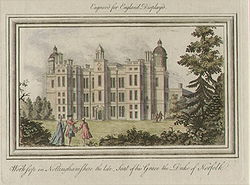
Worksop Manor
Encyclopedia

The Dukeries
The Dukeries was a district in the county of Nottinghamshire which was so called because it used to contain four ducal seats close to one another. It is south of the town of Worksop which has been called The Gateway to the Dukeries...
area of Nottinghamshire
Nottinghamshire
Nottinghamshire is a county in the East Midlands of England, bordering South Yorkshire to the north-west, Lincolnshire to the east, Leicestershire to the south, and Derbyshire to the west...
. Traditionally, the Lord of the Manor of Worksop may assist a British monarch at his or her coronation
Coronation
A coronation is a ceremony marking the formal investiture of a monarch and/or their consort with regal power, usually involving the placement of a crown upon their head and the presentation of other items of regalia...
by providing a glove
Glove
A glove is a garment covering the hand. Gloves have separate sheaths or openings for each finger and the thumb; if there is an opening but no covering sheath for each finger they are called "fingerless gloves". Fingerless gloves with one large opening rather than individual openings for each...
and putting it on the monarch's right hand and supporting his or her right arm.
Worksop Manor was the seat of the ancient Lords of Worksop.
A house was built in the late 16th century for the George Talbot, 6th Earl of Shrewsbury
George Talbot, 6th Earl of Shrewsbury
George Talbot, 6th Earl of Shrewsbury, 6th Earl of Waterford, 12th Baron Talbot, KG, Earl Marshal was a 16th century English statesman.-Life:...
, and probably designed by Robert Smythson
Robert Smythson
Robert Smythson was an English architect. Smythson designed a number of notable houses during the Elizabethan era. Little is known about his birth and upbringing—his first mention in historical records comes in 1556, when he was stonemason for the house at Longleat, built by Sir John Thynne...
. It was for some time the prison of Mary, Queen of Scots. The building was burnt down in 1761. At the same time Smythson also designed the associated Worksop Manor Lodge which survived in substantially original form until 2007 when it was burnt down (probably by local kids) and it is currently being restored.
James Paine was commissioned to build a replacement for the Elizabethan mansion. He planned a roughly square mansion with a vast hall in the central courtyard which would have been one of the largest houses ever built in England, had it been completed. Only one wing had been finished when work stopped on the house in 1767, but even this was on a palatial scale.

Duke of Norfolk
The Duke of Norfolk is the premier duke in the peerage of England, and also, as Earl of Arundel, the premier earl. The Duke of Norfolk is, moreover, the Earl Marshal and hereditary Marshal of England. The seat of the Duke of Norfolk is Arundel Castle in Sussex, although the title refers to the...
, in whose family it remained until 1840.
Following a fire the estate was sold to the Duke of Newcastle
Duke of Newcastle
Duke of Newcastle-upon-Tyne is a title which has been created three times in British history while the title of Duke of Newcastle-under-Lyne has been created once. The title was created for the first time in the Peerage of England in 1664 when William Cavendish, 1st Marquess of Newcastle-upon-Tyne...
of nearby Clumber Park
Clumber Park
Clumber Park is a country park in the Dukeries near Worksop in Nottinghamshire, England. It was the seat of the Pelham-Clintons, Dukes of Newcastle.It is owned by the National Trust and open to the public.-History:...
for £375,000, who ruthlessly asset stripped the site. He demolished the main wing of the house with gunpowder, having sold off the roof lead and some fittings, as he was only interested in adding the land to his own estate. In spite of the money received from salvage and timber he made a huge loss on the purchase which seems to have been animated by anti-Catholic sentiment, the Duke of Norfolk having been a leading Catholic aristocrat. After a number of years the surviving parts of the house, that is the stable, the service wing and part of the eastern end of the main range, were reformed into a new mansion (pictured here), which was occupied for a number of years by Lord Foley. This still survives.
Since at least the first decade of the 20th century the estate has been home to the Worksop Manor Stud, which breeds thoroughbred horses. http://www.tbheritage.com/Portraits/Teddy.html.

